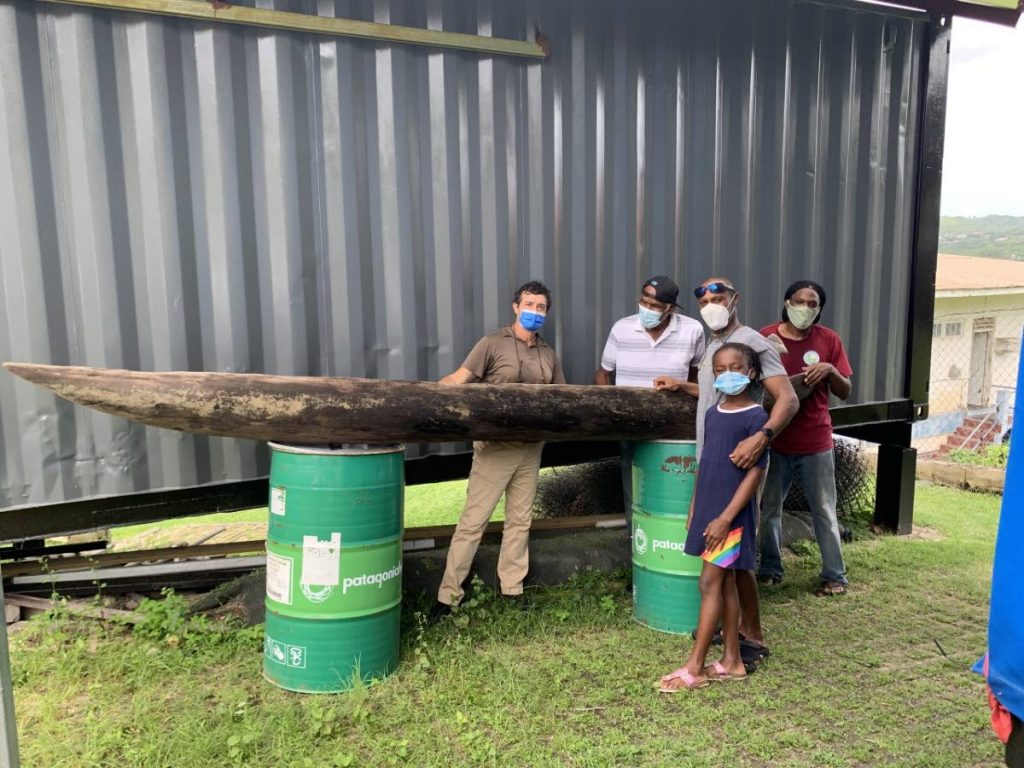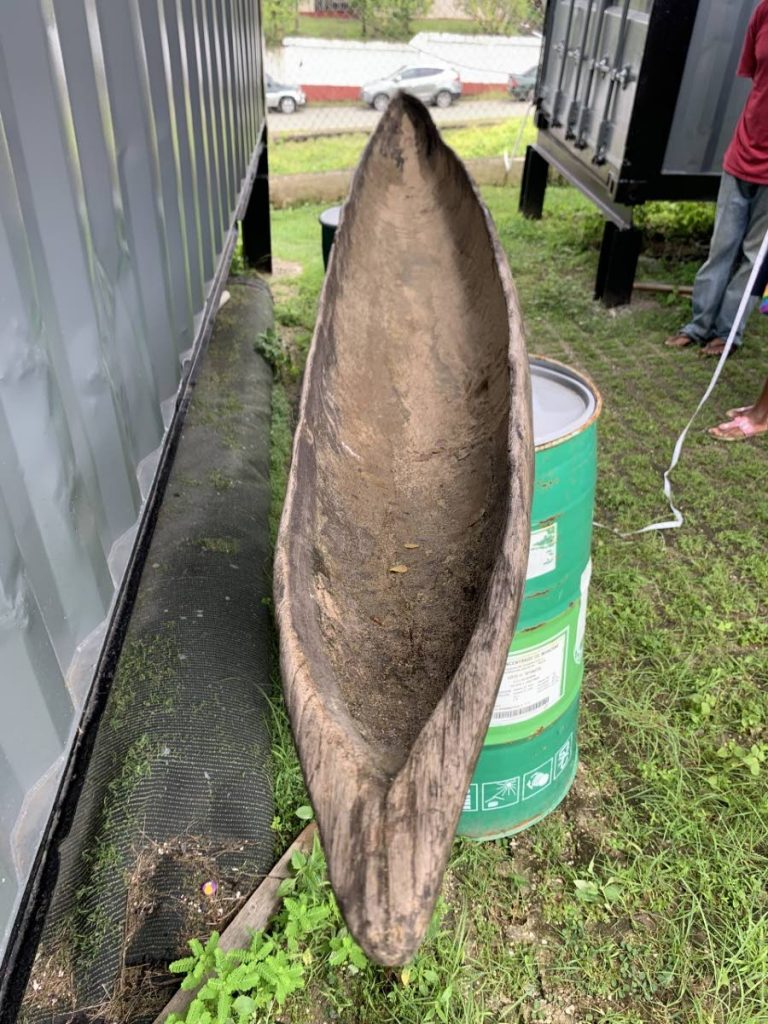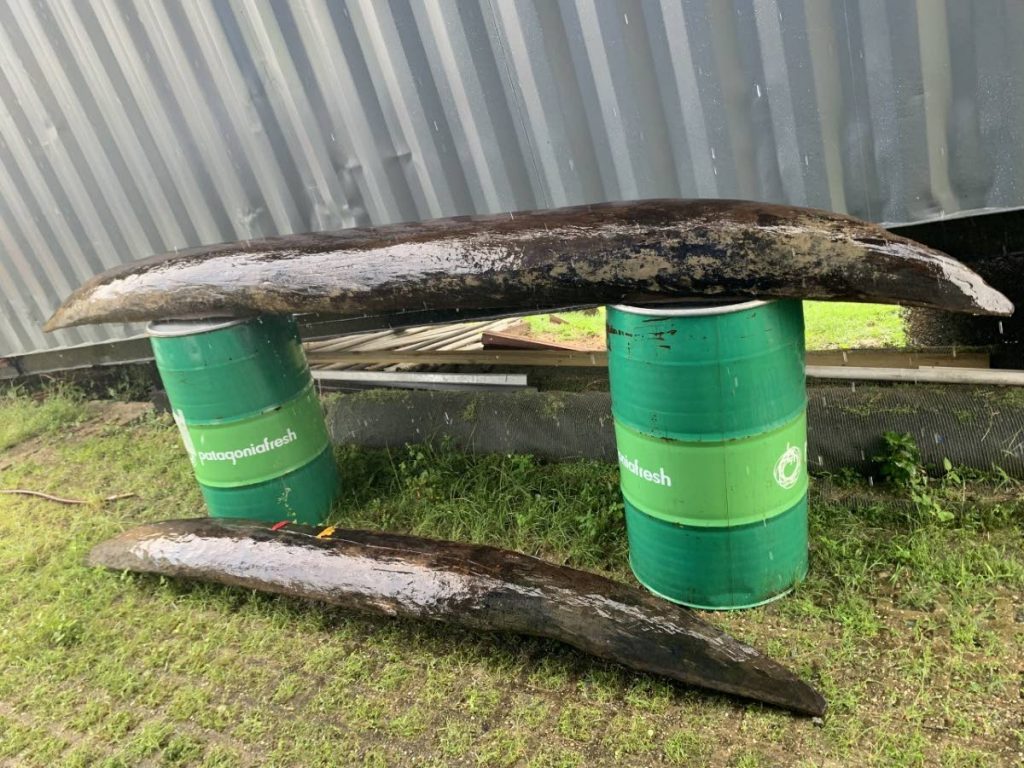Mystery canoes wash ashore in Tobago

Whenever Waltnel Sosa visits his parents in Tobago, fishing is always a priority on his agenda.
Sosa, 43, admits he is not versed in the activity, but finds it relaxing.
On August 17, the Canaan native walked to his usual spot along the beach, behind the Sandy Point resort, Crown Point, for what he thought would be an enjoyable morning of fishing.
But his plan was derailed by the discovery of a dugout canoe (a boat made from a hollowed tree) a short distance from the shore.
He said within 24 hours of that find, another canoe was found on the shore of a beach close to the Magdalena Grand Beach & Golf Resort, Lowlands.
Sosa believes the find could set the groundwork for a different type of tourism in Tobago as the island prepares to rebuild its economy, post-covid19.
“I think people will pay top dollar for data-driven, cultural tourism,” an excited Sosa said in a Sunday Newsday interview.
“If I were to go to a place, I want to find out about its history. I want to understand its story. I don’t just want to sit on a beach. That type of tourism people pay a premium for.”
Now, moves are afoot to determine the origin of the canoes, which has elicited numerous responses from history buffs, heritage-based organisations and average citizens alike on social media.
Sosa recalled when he got to the beach shortly after 6 am, fishing enthusiasts Kern “Ras” Salina and Anderson “Fat Boy” Roberts had already spotted the canoe below a thorn tree.
The men, Sosa said, figured he would be interested in the find.

“When I saw the canoe, I thought it was amazing and I immediately took some pictures of it from different angles. Being from Tobago, I am fascinated by things – waterwheels, windmills – and hearing stories from my father who is into archaeological type of stuff. So I guess I am curious by nature.”
Sosa said the canoe did not appear to have been buried, because it was in reasonably good condition. But he noticed that a lot of water hyacinths (floating aquatic herb indigenous to tropical South America) had washed up on the shore that day.
“I know that those are usually found in rivers in South America, so my assumption is that whatever brought down the canoe washed down the water hyacinths as well.”
He recalled Amerindian artefacts were discovered further along the beach some years ago.
“I felt that experts had to be consulted to determine if the canoes should be put in a museum as part of Tobago’s cultural heritage, because It is important for the country to figure out where this thing was from.”
But Sosa said he did not know who to contact. He brought the issue to the attention of his father, retired school principal Noel Sosa, and several others.
One man, he said, suggested an employee at the Division of Tourism, Culture and Transportation but they got no response. Another felt Radio Tambrin managing director George Leacock would be able to direct them.
Sosa said when they contacted Leacock, he wanted photos of the canoe and asked if they had the manpower to remove it from the beach. Leacock agreed to assist.
Sosa said he and his friend Garth Austin returned to the beach around 2 pm to ensure the canoe was still there.
“The tide was coming up and we had to pull it away from the sea as we waited for Mr Leacock to come.”
The canoe was then transported in a pick-up to a secured location on the island.
That same day, Sosa said he received a call from chairman of the Tobago Heritage Conservation Society Gabriele De Gaetano, who wanted to see the canoe. He said he didn't know about the organisation. but quickly learnt about its work in preserving aspects of Tobago’s cultural heritage, and was impressed.
“I think the work that Gabriele and they are doing is absolutely fantastic. They are all over, cataloguing historical things around Tobago. And he was by far the most responsive when they heard about the canoe.”
De Gaetano did not want to give his thoughts about the find, but preferred to wait until the origin of the canoes was determined.
“Our priority, while waiting to decide the next step, is the preservation of the canoes, since the wood will be outside water. But we have covered the canoes with a cotton sheet to be kept moist,” he told Sunday Newsday.
De Gaetano said he was heartened by the response of individuals and groups to the discoveries.
“It is very important to highlight how the available human resources, involving individuals sharing the passion for heritage, came together from the moment the two canoes were spotted to the moment they were moved to a location comfortable for temporary lodging and inspection. Lots of people followed the unfolding of the events, made inquiries and posted their comments,” he said.
De Gaetano said the Angelo Bissessarsingh Virtual Museum of Trinidad & Tobago on Facebook (ABVMOTT) has also been instrumental in highlighting the canoes and other discoveries of this nature.
He said through the ABVMOTT, which has over 32,700 approved members, with an average of 11,500 views per week, large numbers of people interested in heritage are informed and engaged via very active postings and follow-up.
De Gaetano said the Tobago Heritage Conservation Society’s contributions to the ABVMOTT are limited to the island. He added ABVMOTT administrator Patricia Bissessar and her team recently spent a week in Tobago visiting several heritage sites.

De Gaetano is the director of La Tartaruga Italian Restaurant, Buccoo Bay, His work in preserving Tobago’s heritage began several years ago while he was director of Tobago Affairs for the European Business Chamber in TT (Eurochamtt).
The chamber had started what was called the Tobago Good Food (TGF) Project, which was financed with contributions from the enabling competitive business (ECB) strategy, a programme of the ministries of trade and industry and labour and small and micro-enterprise development.
De Gaetano said the TGF created new agro-tourism sites, offering a unique experience to visitors, who, apart from sampling products, were exposed to dairy farming, apiaries, cocoa production and elements of Tobago’s cultural traditions.
He said after successfully implementing the TGF, Eurochamtt explored the possibility of documenting Tobago’s heritage for future generations.
In 2018, the group Team Museum was formed, with De Gaetano as its chairman. It comprised dedicated volunteers with a passion for history and fieldwork. The group reviewed and organised data collected from previous work and through daily field visits, systematically identified heritage assets at the sites of former estates from the colonial era.
He said the Tobago Heritage Conservation Society was incorporated as an NGO in July 2020 with a mission to preserve Tobago’s heritage assets and promote ecotourism.
De Gaetano said the organisation has been working alongside a team established by THA Chief Secretary Ancil Dennis to develop resources which can be used for public education to add value to Tobago’s tourism product.
He said the organisation has helped with research for the Goodwood Secondary School’s Windmill Ruin Experience and prepared the report of the archaeological and historical sites of estates bordering the Main Ridge Forest Reserve.
This report, De Gaetano said, was submitted in support of the UNESCO Man and the Biosphere project, which was undertaken by Aljosca Wothke, of the Environmental Research Institute Charlotteville. The organisation continues to assist communities with enquiries on cultural matters.
De Gaetano said historical sites and artefacts can contribute significantly to Tobago’s gross domestic product.

“Water- and wind-powered mills; sugar works; colonial water-management systems like impounding and diversion dams, aqueducts; indigo sites; kilns; military sites; cannons; coppers and many other finds, are part of the resources that can offer the opportunity to bring the interested persons to the villages in the seven parishes of Tobago, creating sustainable activities benefiting the communities.”


Comments
"Mystery canoes wash ashore in Tobago"